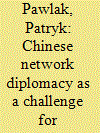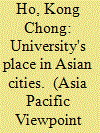| Srl | Item |
| 1 |
ID:
129639


|
|
|
|
|
| Publication |
2014.
|
| Summary/Abstract |
For decades, a prevailing view has been that a very limited number of global issues can be resolved without the USA and European Union acting together. But in recent years, we have seen a growing body of scholarship addressing the question of the 'diffusion of power', 'the rise of the rest' or 'global zero'. With the financial crisis, questionable foreign policy choices and growing global competition from other international actors, both in terms of trade and ideas, the idea of the Western domination is increasingly questioned. At the same time, many international actors, including the European Union, are increasingly shifting-or 'rebalancing'-their attention towards China and other Asian markets introducing new dynamics to old alliances and relationships. Borrowing from the network analysis scholarship, this paper looks at the EU relationship with China through a conceptual lens of 'network power' and 'network diplomacy'. It applies this analytical lens to investigate the implications of EU-China relations for (1) the relations with the USA, (2) the relations with the ASEAN and (3) the effects of the trilateral EU-China-US cooperation on the region.
|
|
|
|
|
|
|
|
|
|
|
|
|
|
|
|
| 2 |
ID:
129637


|
|
|
|
|
| Publication |
2014.
|
| Summary/Abstract |
The global financial crisis (GFC) and subsequent Eurozone sovereign debt crisis (ESDC) have made reform of the global financial governance regime a priority for governments around the world. Prior to the crisis, neoliberal policies agreed between the European Union and the USA created a financial governance regime based on the principle of free operation of the market through the norms of market self-regulation, equal access to the market, and stability via institutional supervision. How will global financial governance look like after these crises? And what role can the EU and China play in shaping this regime? This article argues that as a result of the GFC and the ESDC, stability is becoming a second principle of global financial governance, along with the free operation of the market. Meanwhile, European and Chinese views regarding the norms, rules, and decision-making procedures designed to implement those principles do not differ as much as they used to. Thanks to interactions at the bilateral and multilateral levels, the EU and China now have knowledge regarding how the other understands the role and characteristics that financial governance should have. This is leading to convergence in some areas and cooperation in others. Concurrently, there are also areas of competition. Analysing all of these is essential to understand how global financial governance might evolve, given the central role that the EU and China now play in this regime.
|
|
|
|
|
|
|
|
|
|
|
|
|
|
|
|
| 3 |
ID:
128252


|
|
|
|
|
| Publication |
2013.
|
| Summary/Abstract |
Former Prime Minister of Japan Yasuhiro Nakasone recalls the days when he walked with US President Ronald Reagan and UK Prime Minister Margaret Thatcher. Together they formulated a policy for dealing with the Soviet Union and implemented deregulation to promote a market economy. Here, he recounts the early days of their collaboration.
|
|
|
|
|
|
|
|
|
|
|
|
|
|
|
|
| 4 |
ID:
134161


|
|
|
|
|
| Publication |
2014.
|
| Summary/Abstract |
This paper highlights the relationship between the largest cities in East Asia and the comprehensive research universities that are located there. We look at three strands in this relationship. The first involves students and their perception of host cities, which provides a better understanding of student life and how this connects to the social-cultural environment of the city. The second strand examines the relationship between the university and industry, showing how such collaborations represent university products and knowledge spillovers that connect the university to the metropolitan economy. By examining where students plan to go after graduation, the third strand indicates that the city not only receives student migrants studying in metropolitan universities, it also receives graduates from other East Asian universities. Such third country choices (not returning home or staying in the host country) suggest a new after-study mobility and a small but growing pool of students who are likely to remain in East Asia's largest cities after graduation.
|
|
|
|
|
|
|
|
|
|
|
|
|
|
|
|